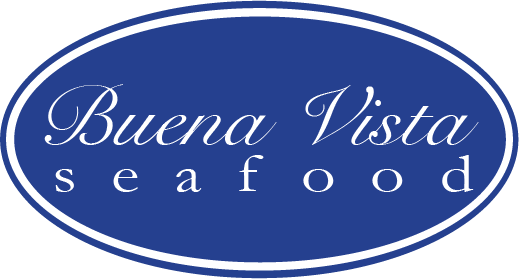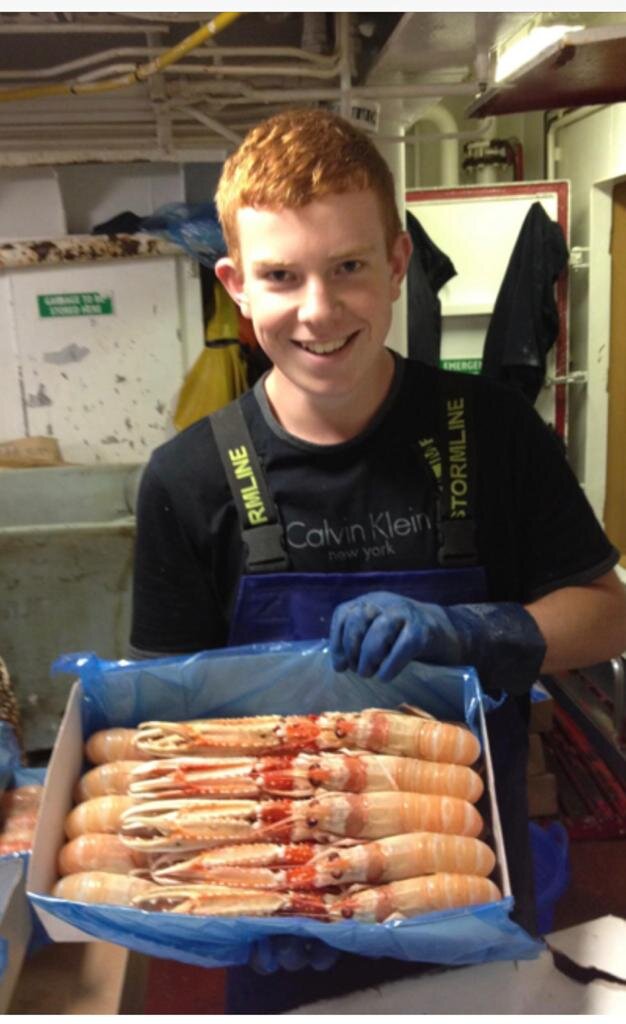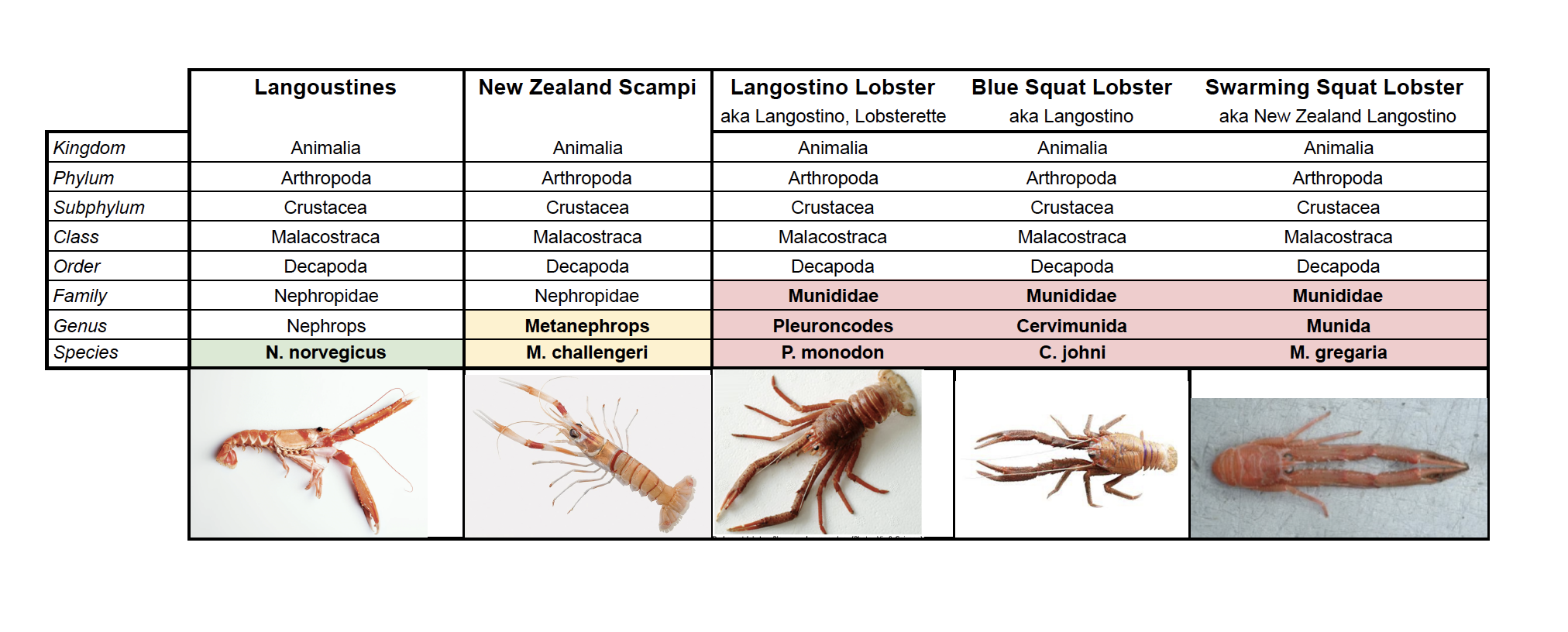Scottish Seas Langoustines
Nephrop norvegicus
Boat-to-Table
Langoustines are part of our Scottish “Boat-to-Table” program. These are the true langoustiens prized by chefs across Europe. We feature fresh langoustines as well as frozen-at-sea (FAS). Each shipment can be traced back to the landing vessel, the captain and home port.
Does a langoustine by any other name taste as sweet?
The Nephrop stands alone!
Nephrops is a genus of lobsters comprising a single species, Nephrops norvegicus which is also known as the Norway lobster or Dublin Bay prawn.
What about New Zealand langsoutines? Nephrop norvegicus vs. Metanephrops challengeri
Although Metanephrops were previously included in Nephrops, the two genera are not sister taxa, Nephrops being more closely related to lobsters (Homarus) than any of the Metanephrops species. Nephrop norvegicus is the ONLY extant species recognized as a Nephrop, while there are 18 extant species recognized as Metanephrops.
Haute Cuisine
Langoustines are what Bon Appetit called "the new marker of haute cuisine." These small, pinkish critters are found in the North Atlantic waters of Iceland, Norway, or Scotland, and as one chef put it to the outlet, "have a more complex and delicate taste than lobster. The flavor is sweet, elegant. Lobster is rustic by comparison."
Prawns are shrimp, and scampi is a dish made with butter and garlic, right?
It’s not quite so simple….
It can be a bit confusing when the Scottish fishermen refer to langoustines as both langoustines as well as prawns. The New Zealand catch is referred to as scampi. So in an effort to get to the bottom of it, let’s take a look where it all comes from.
The term shrimp originated around the 14th century with the Middle English shrimpe, akin to the Middle Low German schrempen, meaning to contract or wrinkle; and the Old Norse skorpna, meaning to shrivel up, or skreppa, meaning a thin person. It is not clear where the term prawn originated, but early forms of the word surfaced in England in the early 15th century as prayne, praine and prane. Scampi is the Italian plural of scampo, referring to Nephrops norvegicus. The Italian word may be derived from the Greek kampē ("bending" or "winding").
It still remains unclear how shrimp, in English, came to be associated with small. But the word does create problems with shrimp-like species that are not small. The expression "jumbo shrimp" can be seen as an oxymoron, a problem that doesn't exist when using "jumbo prawns”, making prawn an attractive marketplace name. In the end there is no clear distinction between the terms and their usage is often confused or even reversed in different countries or regions.
But how does garlic and butter get into the mix? Well, according to the New York Times, “Scampi are tiny, lobster-like crustaceans with pale pink shells (also called langoustines). Italian cooks in the United States swapped shrimp for scampi, but kept both names. Thus the dish was born, along with inevitable variations.”
How did all this confusion come to be?
In short, the terms shrimp and prawn originated in Britain. But with the development of the commonwealth colonies, the word “prawns” and “scampi” were applied to small curly tailed crustaceans found in local waters. This is a lot like the confusion around “yams” and “sweet potatoes”. While they are different, they occupy the same food-space and it was just easier for colonists to adopt and apply the already-anchored name of a “similar” product.
“It’s simply a matter of semantics and name/language usage from different parts of the world. Another example of semantics is the use of prawn vs. shrimp. As the seafood industry has gone global, language use has followed the product from the country of origin.” - Seafood Source
It should be noted that the United Kingdom legally defines scampi specifically as Nephrops norvegicus.
So, Langoustines and Langostinos are not the same?
What’s known as langostinos in the marketplace are actually not related at all to nephrops, but instead are part of the crab family Galatheidae.
The product we see called langostinos are actually squat lobsters. There are several species of langostino, but the one most commonly marketed is Pleuroncodes monodon, which is found off the coast of Chile, and is known as langostino colorado. A related langostino, P. planipes, also called tuna crab, ranges from Baja, California to Peru. A fishery off the coast of El Salvador provides langostino lobster for the U.S. market. In the US, langostino tails are sold mainly in two retail places, Costco and Trader Joe's, and are used by large fast casual chains such as Long John Silver and Rubio’s.
El Salvador and New Zealand produce two other species of galatheid crab marketed as langostino:
Cervimunida johni - which is widely distributed in the Indo-West Pacific: Korea, Japan, Taiwan, East China Sea, South China Sea, Philippines, New Caledonia, Central Queensland, Western Australia, Tanzania, and South Africa.
Munida gregaria - a species of squat lobster found along the eastern seaboard of the South Island of New Zealand, around the southern coast of Tasmania and in a few locations around southern Tierra del Fuego. Its specific epithet (gregaria) derives from its behaviour in the immature phase to form very large shoals or swarms of many tens of thousands of individuals in shallow coastal waters.
Langostinos in hot water
The fast-casual chain Long John Silver’s used to sell lobster bites, but in 2006 the Federal Trade Commission ruled that langostinos cannot be sold as just lobster. They now have to add the word langostino or squat in front of lobster otherwise it would create customer confusion between what many associate with lobster, like Maine lobster for example. So while they are called squat lobster, it's not really lobster but not really prawn either.
In 2005/6 the restaurant chain Rubio’s also came under fire for selling Lobster burritos that contained langostinos instead of lobster. They have now changed the practice and call them langostino lobster burritos.
But in the end, it doesn’t matter what it is called, langostinos are simply neither lobsters nor langoustines.
Buena Vista Seafood Boat -to-Table Scottish program works directly with fishermen to bring fresh and FAS langoustines to chefs in the North American market. Scottish Seas is a fishermen owned entity allowing unprecedented transparency into the Scottish langoustine trade.
The pictures above were taken on board of the F/V Apollo while they were fishing off Porcupine Bank (West of Ireland). We bring langoustines and scallops to the market with hope to expand into other wild catch in the near future.
The last word
The real-deal, super-primo langoustine specimens come from the northeastern Atlantic Ocean, particularly the clear, frigid waters off the coasts of Iceland, Scotland, and Norway. These are the showstopping crustaceans that take center stage across Europe.
Close cousins exist all over the world, notably Metanephrops challengeri, which is sometimes marketed as the genuine article when it is in fact, the “down-under” cousin.
Chefs & Langoustines
Chef Alain Ducasse - The Dorchester
Scottish langoustine, blackberry and nori
Chef Eric Ripert - Le Bernardin
Seared Langoustine; Foie Gras Crouton Balsamic-Truffle Vinaigrette
Chef Helen Darroze
Pan-Seared Langoustines with Tandoori Spices on Carrot Purée with Candied Citrus
Robuchon Atelier - Las Vegas
Langoustine with lemon confit and spring vegetables
Chef Yannick Franques
Langoustine with futaba and yuzu



